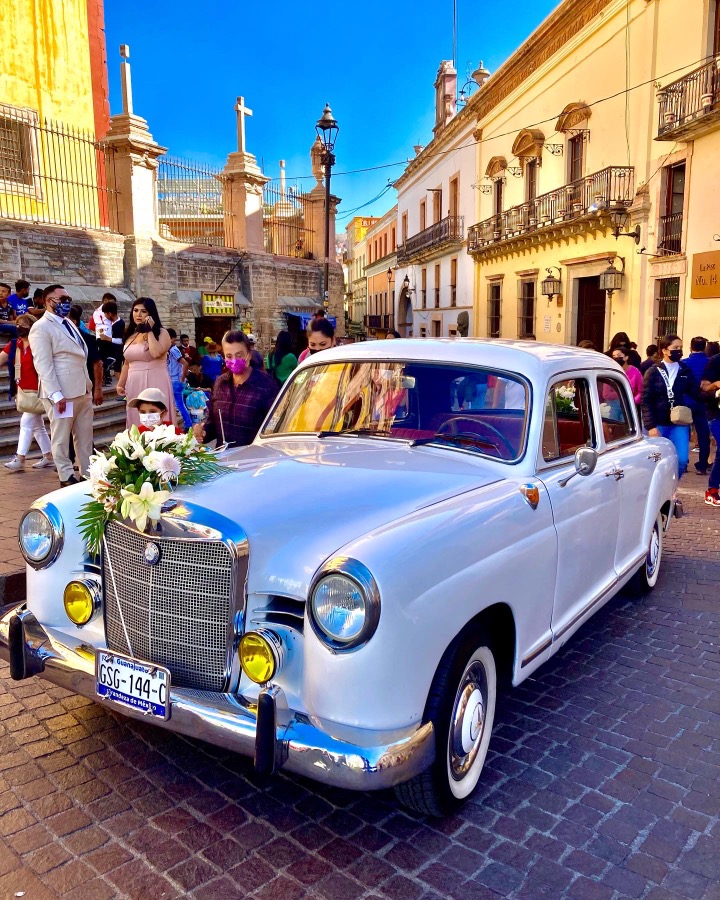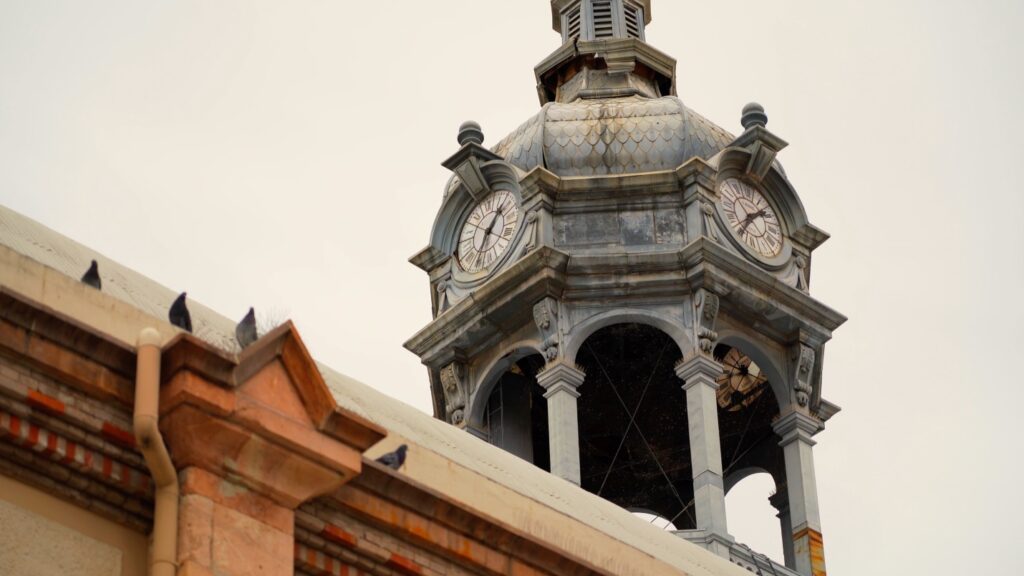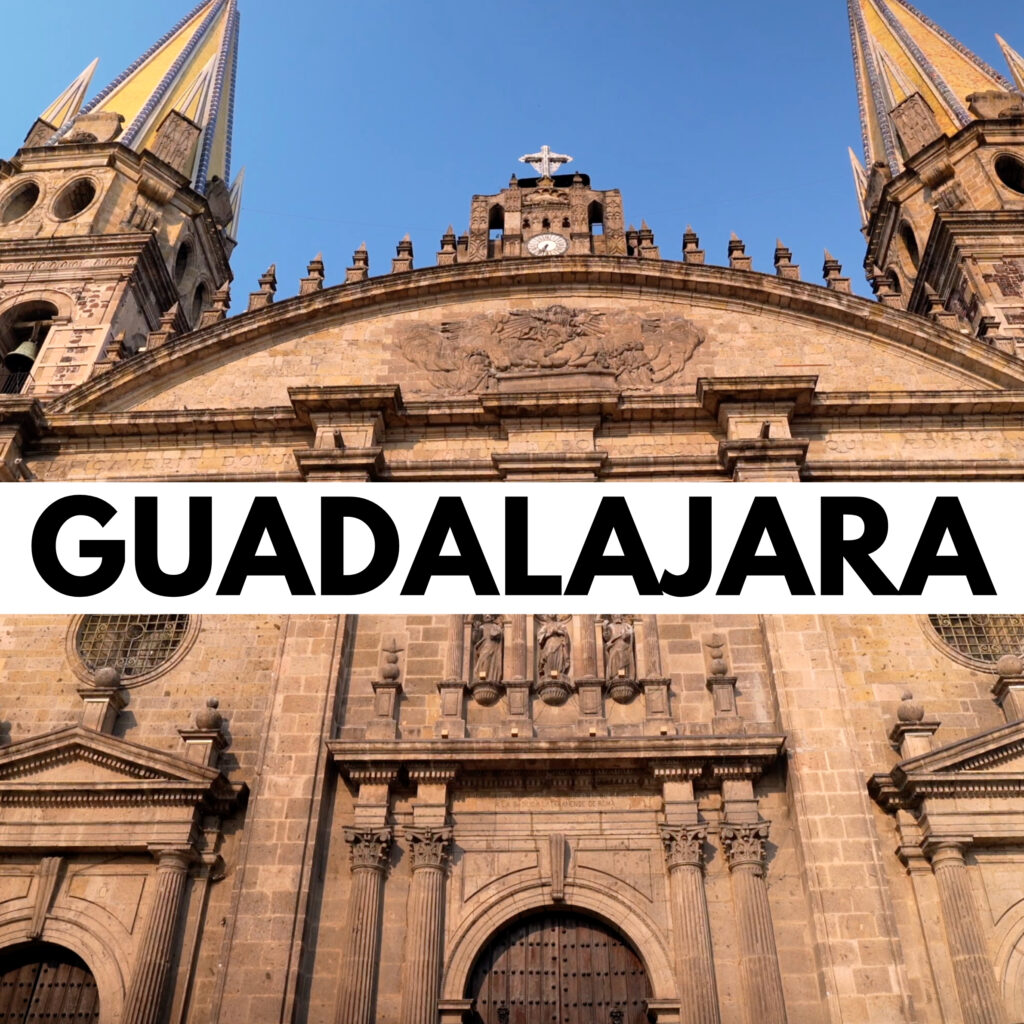All of my previous trips to Mexico had been to the beach. I even lived in the beach town of Puerto Vallarta. Guanajuato would be my first real experience of a mountain town in Mexico, and I was excited to check it out. We took a quick, 45 minute flight straight from Puerto Vallarta to Guanajuato. The airport is actually closer to the city of Leon than Guanajuato, but it was still only about a half hour ride from the airport to Guanajuato city.

Dubbed as the prettiest city in Mexico, Guanajuato is known for its silver mining, colonial architecture, narrow winding cobblestone streets, and fascinating history. The whole city was declared a UNESCO World Heritage Site in 1988.

Getting into the city was one of the most interesting driving experiences. Being an old city with narrow streets, and much of the city built into the surrounding hillsides, traffic is diverted underground to the Guanajuato Tunnels. These tunnels were not originally constructed for traffic, but as a way to divert water from the Rio Guanajuato to prevent flooding, in the early days of this historic mining town. Now there is a dam that helps control the river during the wet season, so when the tunnels were due to receive some maintenance in the 1960s, the city saw a way to help divert the ever increasing traffic coming through the narrow streets of the city. The tunnels were widened, reinforced, and converted to traffic tunnels. Today, the tunnels take east bound traffic and only west bound traffic actually passes through the city center. These tunnels are a unique sight in Guanajuato, they boast decorative entrances and sidewalks for pedestrians. They are huge as well, with trucks, heavy equipment, and buses able to easily pass through. Some of the city’s main bus stops are located in the tunnels. They are also very well lit and safe to walk through, we used them quite a few times for a faster route. They are a charming addition to the city and I think other cities could definitely copy this system to help manage traffic.







One of the first things we did was to take the Funicular Panoramico up the steep hillside and take in the amazing views of the city. The funicular is only 35 pesos for a ride to the top. A ride back down is 70 pesos. You can easily walk down if you prefer. The funicular uses two cars that are counter weights. One goes up as the other comes down.

After reaching the top and seeing all the pink, blue, yellow, and white buildings built into the hillsides below reminded me of pictures I had seen of the hillsides of the Cinque Terra on the Italian Riviera. It really is a stunning sight and you can see why this is named the prettiest city in Mexico. Along with art, souvenir, and food vendors at the top, there is also a massive memorial statue dedicated to a local hero called “El Papila”. The statue displays the inscription of El Papila’s words, “There are still other alhondigas to burn”.



Juan Jose Martinez was a miner who was born with a physical disability that affected his walking. Due to this he was dubbed El Papila, or the turkey. After seeing this massive monument I had to find out more of El Papila’s story. I found this at the Regional Museum of Guanajuato, also known as the Alhondiga de Granaditas. This was a granary until the Spanish turned it into a fortress to protect themselves from the rioting masses during the Mexican War for Independence. On September 28, 1810, 300 Spanish troops decided to hold up here as the granary had all the supplies they needed and was virtually indestructible. It’s only weak point being one wooden door. Known for his great strength, El Papila strapped a large, flat slab of stone to his back to protect himself from bullets and rocks. As these were fired at him, he was able to douse the wooden door with oil and set it on fire with a torch. Led by El Papila, the insurgents stormed the granary through the burned door. That day all 300 Spanish troops were killed. That was also the day El Papila made his famous statement “There are still other alhondigas to burn” knowing that it would be a long fought road to freedom. This was the first confrontation in the Mexican Independence Movement. Mexico finally won their independence in 1821. El Papila’s bravery sealed his spot in history as a local hero and legend.




In 1867 the granary building was converted into a prison, and remained so for more than 85 years. Then in 1958 the building officially opened as a museum. Taking almost twelve years to complete, the famous artist Jose Chavez Morado painted one of the most vibrant and stunning murals in the museum, that reflects the historical significance of the area and Mexico’s Independence Movement.



The museum also houses a large collection of fascinating Pre-Colombian art, donated by Morado, along with a collection of photographs done by the famous Mexican photographer Romualdo Garcia. These photos catalog the separation of classes, or caste system, during the time period of the late 1800s to the 1930s. I found it an incredible glimpse into history. This place is exceptional and you can easily spend several hours in here. I loved it and would gladly visit here again.



We stayed in a great little Airbnb right in the heart of the city, close to the Plaza de La Paz and near the Basilica of Our Lady of Guanajuato. This beautiful basilica is home to the Our Lady of Guanajuato statue. The oldest statue of the Virgin in all of the Americas. Made in Andalusia, Spain in the 8th century, it was a gift to Guanajuato for all of the wealth it had brought to Spain from it’s silver mines.



The street that runs in front of the Basilica is the happening place to be in the evenings. We often ate dinner on this street and had a great view of the Basilica. We saw several wedding parties and their festivities as they came out of the church for photos. At night vendors, mariachis, and street entertainers gather in this area. We saw Mickey & Minnie, Sponge Bob, Ironman, and a few others that you could have your photo taken with. There was a Keanu Reeves look alike you could pose with and I have to say the resemblance was a little shocking. Although Guanajuato is popular with international tourists, most of the tourists here are Mexican families on vacation.

Guanajuato is a walker’s paradise, with a few hills thrown in. Walking the streets here you can see beautiful architectural designs and explore the buildings of the epic Teatro Juarez, the University of Guanajuato, and the Temple of the Oratory of San Felipe Neri. As beautiful as these grand buildings are, I loved just strolling the narrow, cobblestone, barrio streets and alleyways. Some of these are walled streets with brick archways and walkways connecting them overhead. Some streets are so close together, as highlighted by the beautiful Callejón de Beso, or Alley of the Kiss. So named because the balconies are close enough for a couple to reach across and kiss. And you and your partner can do just that and have your picture taken. Guanajuato just has that inexplicable feel that some places have. I can’t quite find the right word, but you get that feeling that you could easily fall into the groove of this city and spend some real time here.





To add to this, we were out walking around one afternoon and went down one of these narrow streets and stumbled upon one of the most interesting and eclectic places, La Clave Azul Restaurante y Taberna. This place has been here several decades and has gained a somewhat legendary status. Built with several levels of cozy nooks and a rooftop for drinking and dining, it’s not fancy, but La Clave Azul should not be missed. Decorated with all kinds of collectible movie and music memorabilia, they mix a great cocktail here, with Mezcal being their speciality. Depending on the day, they bring you free tapas with your drink. The more drinks you order the more free tapas you get, and each one is tastier and heartier than the last. If you go on a day when tapas aren’t being served, they have a great menu you can order from. You have to go with the flow at this place, don’t be in a hurry. Lean back and enjoy the musicians that come and go, playing a few songs on a guitar or violin. If the owner is there, he will come and chat and bring you tapas himself. The waitstaff are delightful and it’s a great way to spend several hours or a whole afternoon/evening.

There is an incredible place to visit in Guanajuato unlike any place I have visited before. The Museo de las Mumios, or the Museum of Mummies. In the late 1800s a tax was imposed for perpetual burial. If a deceased persons family could not pay the yearly tax, or the family could not be found, the persons remains were dug up and became government property. Wow, I had always been under the impression that burial was always perpetual, but I guess the government can tax you for anything! Unbelievably this tax was in place until 1958. Because of the dry climate here, a portion of these unfortunate peoples’ bodies had mummified. For several years the cemetery workers kept the best ones and charged a small fee for people to view them. This eventually became the museum.





Today there are 111 mummies on display, making it the largest collection of natural mummies in the world. This place is not family friendly, or for the faint of heart. But it is incredibly interesting. Some are still in the complete outfit they were buried in. You get a glimpse into the past at the differences of status seen in clothing, hairstyles, and even footwear, between the rich and the poor. A few are a little gruesome to see, others look like perfect mummified specimens. The saddest to see were the little children and babies.

There was even a mother and baby that had been buried together. It was a very informative museum and done as tastefully as the Egyptian and Peruvian mummies I have seen elsewhere. The museum is attached to the Panteón Santa Paula, or the Santa Paula Cemetery where they had originally been laid to rest. Walking around the cemetery itself was very interesting as well with headstones and memorials dating back to 1865. You can find everything from a small, simple stone cross engraved with name and date of death, to full on sculptures of generals, governors, and the elite.
Before arriving in Guanajuato, I did some research to find out all the places we should visit while we were there. I was pleasantly surprised to find out that there is a Don Quixote art gallery, and I didn’t think much more about it. I happened to be reading the book Don Quixote, by Miguel de Cervantes at the time, and thought it would be cool to check the art gallery out. But after arriving, as we walked the cobblestone streets of Guanajuato every day, I had started noticing t-shirts, mugs, keychains and all kinds of memorabilia with pictures of Don Quixote and his sidekick Sancho Panza. We went to the art gallery and it was wonderful. Then I found out that Don Quixote is the subject of more than just the art gallery. We came across a park with huge sculptures of Don Quixote and Sancho Panza, and a Teatro Cervantes, or Cervantes Theatre, and a Cervantes Museum.

To top it off I found out that Guanajuato is home to the International Cervantino Festival. I was a little confused as to what the fixation with Don Quixote was. I knew that the book was written in 1605, by Miguel de Cervantes, in Spain, and that Cervantes never came across to Mexico. I found out the most interesting story about a certain Eulalio Ferrer. Born in Spain, Ferrer was the youngest captain in the Spanish Civil War, at age 19. When the war turned in favor of the Nationalists, he fled to France. He spent two years in a refugee camp living in deplorable conditions. One day he traded some cigarettes for a much worn copy of the book Don Quixote. He later stated that this book saved his sanity and that he had read it over 100 times. As the threat of WWII drew near, Ferrer emigrated to Mexico. Over the years he turned into one of the leading entrepreneurs in Mexico. Because of the book he had amassed an extensive collection of Don Quixote memorabilia. He finally moved his large collection from Mexico City to Guanajuato and opened the Cervantes Museum. The International Cervantino Festival he started in 1972 is now considered perhaps the most important international artistic and cultural experience in Latin America, and one of the biggest events of its type in the world. The festival celebrated its 50th year in 2022 and saw over 500,000 visitors to the city for this three week long event. Celebrated in October, I would absolutely love to be there and attend it one day.

You have never really visited a place until you go to the local market. Located on Avenida Benito Juarez is Guanajuato’s central market, the Mercado Hidalgo. This place is rustic and authentic! You can find fresh flowers, fruits, vegetables, herbs, meats, fresh made tortillas, and food stalls on the lower level. The upper level boasts, handicrafts, leatherworks, tee shirts, souvenirs, shoes, clothing and much more. We ate lunch here a couple of times and it was delicious! The ladies at the food stalls vie heavily for your patronage, but whoever you go with (or make eye contact with), you’re sure to get a great meal from.



Another great spot to visit is the Union Gardens Square. Lined with some nice, but touristy restaurants, it is packed in the evenings. It does get to be a little much sometimes as they try to out do each other with loud music as the evening wears on. Right across the street from the Union Gardens you will find the Callejoneadas Guanajuato. If you are not approached by a Calleoneada, you can book a tour here. This is a very fun way to get to know some of the history of the historic city center. A Callejoneada is similar to a troubadour or wandering minstrel. These are estudiantes, or college students, dressed in historic 17th century Spanish costume, complete with capes. They look very dashing as they take small groups of people through the narrow alleyways and streets of the historic city. They tell stories, play the guitar, and sing songs, all involving Guanajuato’s history. They begin at sundown and go until about midnight. It’s more like a party than a walking tour.
As I previously stated, Guanajuato is a walker’s paradise. The more we walked around the city, the more things we discovered. One morning we happened upon Plaza de las Renas, or Frog Square. The name Guanajuato is an indigenous word meaning “the place of frogs”. The frog is also the symbol of the city and you will see frogs displayed in many places. This plaza had some nice fountains and many frog sculptures. It also had a nice shady grass area to relax in.

Just walking the streets here, you are treated with beautiful murals and sculptures on almost every block, along with some very nice art galleries. The art scene is huge in Guanajuato and how could it not be, this is the birthplace of Diego Rivera. We visited the Museo Casa Diego Rivera. This is the home where Rivera was born and raised. I wasn’t expecting much and I ended up being very pleasantly surprised. The family furnishings were still in some of the main rooms of the house, and other rooms contained over 100 of Rivera’s paintings and drawings on display. It was really fantastic. Rivera was an illustrious Mexican painter and muralist famous for his works of high social content. He was also the husband of another one of my favorite artists, Frida Kahlo.


I really fell in love with Guanajuato. Our time here went by way to quickly. There was so much to see and do, and we did not get to do it all. Guanajuato is at the top of my list of places I want to go back to in Mexico. The art, the architecture, the beautiful streets, and the friendly people combined to make such an inviting ambiance. Maybe next time we can come for a month or two and we can settle into that local groove!
Check Out Our Guide To Guanajuato Video!


